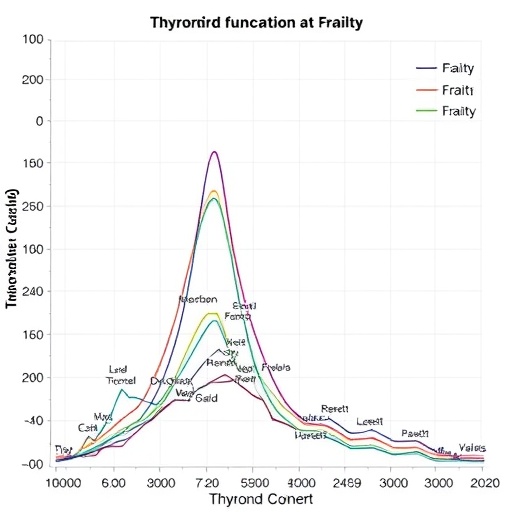In the realm of geriatrics, the quest for tools that enhance elderly care becomes increasingly vital, especially as populations worldwide age at an unprecedented rate. A landmark study led by a team of esteemed researchers, including Shi, X., Yang, H., and Wang, S., has emerged, focusing on the intersection of thyroid function and frailty in older adults. This research is not merely academic; it seeks to create a real-world impact through the development and validation of a predictive nomogram—a graphical representation of a predictive model. Such a tool could revolutionize how healthcare professionals assess and manage frailty, a condition detrimental to the health and quality of life of seniors.
Thyroid function has long intrigued researchers due to its pivotal role in metabolism and overall health. In older adults, disturbances in thyroid activity can have far-reaching consequences, leading to various health issues, including frailty. This phenomenon is characterized by a decline in physiological reserve and increased vulnerability to adverse outcomes, such as falls and hospitalization. The research group aimed to investigate the relationship between thyroid function parameters and frailty, offering insights that could empower clinicians with predictive capabilities.
The study’s methodology was comprehensive and well-structured, employing a robust dataset of older adults to derive meaningful conclusions. Participants underwent a thorough assessment, including evaluations of their thyroid function through blood tests and comprehensive frailty assessments. The resulting dataset enabled the researchers to construct a nomogram – an innovative statistical tool that calculates individual risk levels based on multiple variables, which, in this case, included thyroid hormone levels among various other factors associated with frailty.
The validation of the predictive nomogram forms a crucial part of the study. The researchers meticulously tested the model against an independent cohort of older adults to ensure its robustness and accuracy. This step is essential; a predictive tool’s clinical relevance hinges on its ability to perform reliably across diverse populations. The validation process not only confirms the model’s utility but also its potential to be integrated into clinical practice, guiding healthcare providers in identifying individuals at risk of frailty.
As the study unfolds, it reveals the intricate mechanisms connecting thyroid function to frailty. Hypothyroidism, characterized by insufficient levels of thyroid hormones, poses a significant risk for the elderly population, leading to increased frailty. Conversely, hyperthyroidism can cause its own set of complications, often resulting in unintended weight loss and further frailty. By understanding these relationships, healthcare practitioners could take proactive steps towards managing thyroid health in older adults, potentially staving off frailty and related complications before they take root.
The implications of this research extend beyond academic circles. Early identification of frailty risk through the nomogram could lead to timely interventions, including thyroid hormone replacement or lifestyle modifications. Such proactive measures could enhance the quality of life for countless older adults, providing them with the support they need to maintain their independence and overall well-being. The prospect of integrating this nomogram into routine health assessments inspires hope and signifies a step forward in personalized medicine for the aging population.
In addition to direct clinical applications, this research encourages a broader discourse on the importance of thyroid health monitoring in older adults. As healthcare systems adapt to the challenges posed by aging populations, understanding how various biological factors contribute to frailty is paramount. This study underscores the necessity of interdisciplinary approaches in geriatrics, where endocrinology and geriatric medicine converge to optimize patient care.
Moreover, the study advocates for continued research into the myriad factors influencing frailty. Thyroid function is just one piece of a complex puzzle, and ongoing investigation could unearth additional predictive markers that enhance our understanding of aging. Future studies might explore genetic variables, lifestyle factors, and co-morbid conditions that synergistically impact frailty, leading to more comprehensive models that guide clinical practice.
The publication of this research in a reputable journal reflects the scholarly significance and potential impact of the findings. As practitioners and researchers alike digest the implications of this study, it sets the stage for conversations about how to leverage innovative tools like nomograms in everyday practice. The healthcare landscape is evolving, and the integration of predictive analytics into patient care represents a forward-thinking approach that aligns with contemporary healthcare goals.
Equally noteworthy is the potential for this research to inform policy decisions. As populations age, healthcare systems face mounting pressures to allocate resources efficiently and effectively. By identifying frailty risk early, healthcare providers could potentially reduce the burden on healthcare services, leading to more sustainable outcomes and improved care delivery in the geriatric domain. Policymakers must take heed of such findings, considering the economic and humanistic benefits of early intervention in frailty management.
Ultimately, this groundbreaking research offers tangible benefits to the field of geriatric medicine. The nomogram developed by Shi, Yang, Wang, and their team promises to streamline the assessment of frailty in clinical settings, facilitating targeted interventions that could significantly enhance the quality of life for older adults. As we stand at the crossroads of innovation and practice, embracing such developments is essential for shaping the future of elder care.
In conclusion, the development and validation of this predictive nomogram mark a vital advancement in our understanding of frailty and thyroid function in older adults. As the academic and medical communities continue to explore these connections, the potential for improved health outcomes in the aging population becomes ever more promising. With the right tools and insights, we can help ensure that older adults lead healthier, more independent lives—a goal that lies at the heart of modern geriatrics.
Subject of Research: Frailty based on thyroid function in older adults
Article Title: Development and validation of a predictive nomogram for frailty based on thyroid function in older adults.
Article References:
Shi, X., Yang, H., Wang, S. et al. Development and validation of a predictive nomogram for frailty based on thyroid function in older adults.
Eur Geriatr Med (2025). https://doi.org/10.1007/s41999-025-01247-3
Image Credits: AI Generated
DOI: https://doi.org/10.1007/s41999-025-01247-3
Keywords: frailty, thyroid function, elderly care, predictive nomogram, geriatrics.




